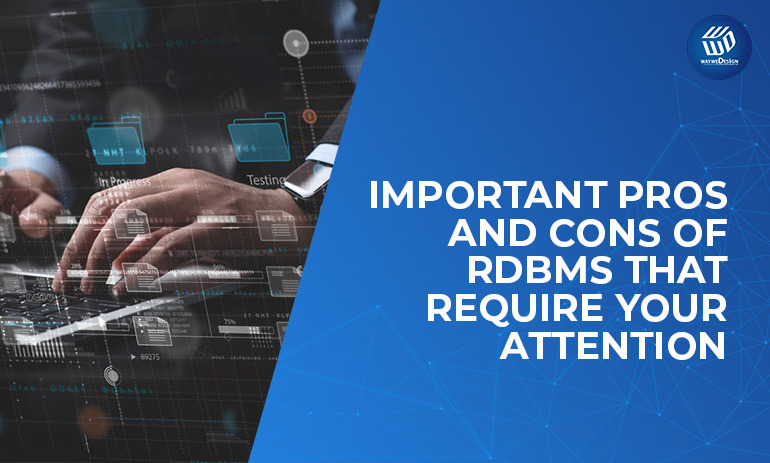Way WeDesign, India

Important Pros and Cons of RDBMS that Require Your Attention
Since its ancient inception by the venerable Codd, RDBMS has reigned as a powerful database model. Its regimented relational structure marshals data into orderly tables, with rigid ranks and files enabling complex querying.
Yet RDBMS demands deep expertise, its schema stubbornly resisting change. Massive resources are required to scale its mega structure. Still, adepts harness its might to raise glorious data monuments. Thus RDBMS merits study - know its limits, employ its strengths judiciously. With wisdom, one may tame this database behemoth.
What is RDBMS?
RDBMS, short for Relational Database Management System, is a database model that structures data into tables. These tables consist of rows and columns, forming a grid-like format for organized storage. Beyond just containing data, RDBMS also defines the interrelationships between different data elements, enabling powerful querying and rapid retrieval.
This relational structure and ability to illustrate connections make RDBMS a versatile database solution. It is widely utilized across diverse industries, from business to finance, ecommerce, healthcare and more. From tech giants like Microsoft and Oracle to open-source champions MySQL and PostgreSQL, RDBMS reigns supreme. It's the go-to platform for managing and organizing the lifeblood of business - data. SQL-wielding knights protect and secure these data treasures, while pretenders fail to topple the king. For structured data, old RDBMS still holds the crown and the keys to the kingdom.
By organizing information into related tables, RDBMS brings order to data, making it easier to manage and optimize no matter the scale. This clear structure and query capabilities explain why the relational model is a go-to database choice for many organizations.
The key functions of a Relational Database Management System:
At its core, an RDBMS provides structured storage for data in interrelated tables. It enforces integrity through data types, constraints, and relational rules. SQL enables flexible queries and manipulation of stored data.
Retrieving meaningful insights from the database is powered by indexing for performance, and relationships between tables that unlock complex querying.
Robust security features control access and safeguard sensitive information. Transactions allow grouping operations into all-or-nothing units for consistency.
The RDBMS gracefully handles concurrent users accessing and modifying data through isolation mechanisms. Backup and recovery capabilities guard against data loss events.
Scaling both vertically and horizontally accommodates increasing data volumes and usage. Data normalization and constraints ensure quality is maintained as the database grows.
Reporting tools and analytics capabilities empower end users to derive value from the raw data. The RDBMS is ultimately a vehicle for turning data into actionable business intelligence.
Comparison of the key Pros and Cons of RDBMS:
PROS
• Data integrity enforcement through constraints
• Structured organization into tables with predefined schemas
• Ability to define relationships between tables
• Effectual data recovery and manipulation using SQL
• Transaction support ensuring ACID compliance
• Data security features like access control and encryption
• Indexing for faster queries and scalability
• Data normalization to reduce redundancy
• Mature technology with extensive community support
CONS
• Architectural complexity makes it challenging to implement, manage and scale
• Schema rigidity limits adaptability to new data models
• Performance overheads like indexing impact efficiency
• Scaling can be expensive and hit technical limits
• Proprietary vendor lock-in limits flexibility
• Steep learning curve for SQL and data modeling
• Concurrency and optimization demands grow with large data volumes
Advantages of Employing a Relational Database Management System
I. RDBMS platforms provide robust tools to organize, protect, and utilize structured data. Their relational model establishes clear connections between database entities, enabling intuitive data modeling. SQL empowers users with a flexible language to efficiently query and manipulate data.
II. Rigorous integrity constraints and ACID compliance ensure data accuracy and transactional reliability. Security features like access control and encryption safeguard sensitive information. Indexing and normalization optimize storage and boost query performance.
III. RDBMS supports analytical reporting to unlock insights from stored data. Scaling capabilities accommodate increasing data and workload demands. Extensive community resources help overcome technical challenges.
Key factors to consider when evaluating RDBMS vs NoSQL
• Data Structure - RDBMS works well for structured relational data. NoSQL better handles unstructured and variable data.
• Transactions - If robust ACID transactions are required, RDBMS is likely the better choice. NoSQL has basic transaction support.
• Queries - For complex query capabilities, RDBMS leverages SQL and indexing. NoSQL optimizes for simple read/write.
• Scalability - NoSQL more easily scales distributed data across low-cost hardware. RDBMS scaling is costlier and complex.
• Agility - NoSQL's flexible schemas allow quick iteration. RDBMS schema changes are cumbersome.
• Cost - NoSQL databases require less hardware and expertise for large implementations. RDBMS costs grow substantially at scale.
• Analyze your data structures, query patterns, scalability needs and budget to determine if RDBMS or NoSQL better fulfills your requirements. The use case specifics will guide the optimal database decision.
Relational databases like RDBMS offer mature, robust technology for managing structured data, but come with limitations in flexibility, scalability, and complexity. The RDBMS decision requires evaluating your specific needs - if you need transaction support, complex data relationships, and rich querying, RDBMS may be the optimal choice. However, for semi-structured data or rapidly evolving schemas, a NoSQL alternative may suit your requirements better. Carefully assess your data models, querying needs, scalability demands, and budget constraints. While RDBMS brings key advantages to many use cases, there is no universally ideal solution. Weigh the pros and cons against your unique requirements to determine if RDBMS or NoSQL is the right fit.
